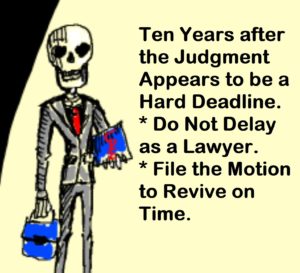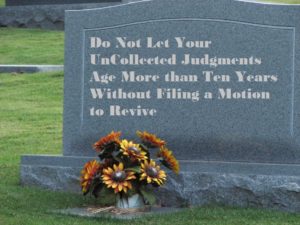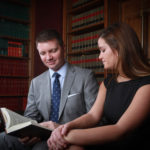 The Death of Your Claim – How to Preserve or Lose Your Judgment at the Ten Year Mark
The Death of Your Claim – How to Preserve or Lose Your Judgment at the Ten Year Mark
It is wrong to presume that once you receive your judgment, it will be good forever; and if one cannot collect through insurance, or garnishment, or a judgment lien now, then one merely has to wait, and eventually your judgment will have to be paid. This is wrong. Missouri law, like the laws of many jurisdictions, presumes a judgment is satisfied and paid in full after a period of ten years. This is irrespective of whether the judgment debtor made payments. A Motion to Revive Judgment will be needed.
THE TEN YEAR LIMIT APPLIES TO ANY JUDGMENT – FOR HERE, LET US USE A CAR CRASH
A Lee’s Summit rear-end auto accident happened on May 1, 2009. John, the negligent driver, was driving his 2007 Ford F-150 pickup truck south on Missouri State Route (Highway) 291 just past Hy-Vee grocery store through the stoplight at Langsdale Road in Lee’s Summit. He ran that stoplight. John collided with the rear of the Honda Civic driven by Molly as she was turning left from Langsdale onto 291 Highway. Molly suffered severe injuries to her back including a compression fracture of her C1 vertebrae and a herniated disc at the L5-S1 level in her lower lumbar spine. Molly was taken by ambulance and treated at Saint Luke’s East hospital in Lee’s Summit. Her orthopedic surgeon diagnosed the L5-S1 disc herniation and treated her neck C-1 compression fracture. Molly went through physical therapy, in Lee’s Summit for her auto collision injuries.
JUDGMENT FAULT DOES NOT MATTER REGARDING THE TEN-YEAR DEADLINE
John received a ticket from Lee’s Summit Municipal Court for careless and imprudent driving. He did not hire a criminal defense lawyer but rather pled guilty and was convicted of this 4-point offense. John’s Lee’s Summit ticket conviction acted as an admission of fault for the motor vehicle accident.
LAWSUITS ARE SOMETIMES NEEDED EVEN WHEN ACCIDENT FAULT APPEARS CERTAIN
Molly sought money compensation for her Lee’s Summit accident injuries from John. Molly hired Lee’s Summit personal injury lawyer Matt Hamilton. John was assigned a defense lawyer by his auto insurance company. Fault was denied in spite of the Lee’s Summit Municipal Court conviction. The insurance defense lawyer also alleged Molly was comparatively at fault for turning left too slow. The defense lawyer argued her auto accident damages should be reduced by her percentage of fault, even though John was the cause of the car crash. The insurer refused to pay Molly’s reasonable damages prior to a lawsuit. Molly was forced to sue John in the Circuit Court of Jackson County at Independence, where Lee’s Summit auto accidents are filed.
THE JUDGMENT
The lawsuit proceeded to judgment. Molly and her personal injury attorney won a $650,000.00 judgment against John, with a finding john was 100% the person who caused the Lee’s Summit collision.
The verdict was handed down October 10, 2009. It was determined that John had failed to pay his auto accident insurance prior to the car crash and the insurance company had properly ended his coverage. John was uninsured at the time of the auto collision. John made three payments to Molly in November 2009, December 2009, and January 2010. Afterwards, John stopped making any payments on the verdict against him. Molly attempted to garnish John’s wages and collect against his insurer, to no avail.
TEN YEARS IS FROM THE DATE OF JUDGMENT AND NOT SOME OTHER EVENT
The judgment sat until October 1, 2019. At that time, Molly made a motion to revive the judgment. Molly properly preserved her judgment. Let us presume, however, that she waited until October 20, 2019, ten tears and ten days post Judgment. Molly argued to the court that more than ten years had elapsed since the judgment. It has been less than ten years since payments were made by John. Who is right? Can Molly revive her judgment and collect against John? Is John right and the judgment is now dead?
MISSOURI LAW ON REVIVING JUDGMENTS
 Section 516.350 of the Revised Statutes of Missouri governs the revival of judgments. It indicates any judgment against a person (or entity) must be revived within ten years of its creation. The Court of Appeals in Unified CCR Partners v. Abright No. ED106082, 2018 WL295711 (Mo.App June 12, 2018) recounted the law in this matter. In order to revive a judgment, a party who receives the judgment may file a motion to “revive the judgment” within ten years of either the date of the judgment itself, or the date of the last revival. This was also expressed in Dummett v. Koster, 446 SW 3d 732, 734-35 (Mo. App. 2014). The important part is that the motion to revive must be filed within ten years of the Judgment or within ten years of the date of the last revival itself (if more than twenty years). The date of the last payment does not matter.
Section 516.350 of the Revised Statutes of Missouri governs the revival of judgments. It indicates any judgment against a person (or entity) must be revived within ten years of its creation. The Court of Appeals in Unified CCR Partners v. Abright No. ED106082, 2018 WL295711 (Mo.App June 12, 2018) recounted the law in this matter. In order to revive a judgment, a party who receives the judgment may file a motion to “revive the judgment” within ten years of either the date of the judgment itself, or the date of the last revival. This was also expressed in Dummett v. Koster, 446 SW 3d 732, 734-35 (Mo. App. 2014). The important part is that the motion to revive must be filed within ten years of the Judgment or within ten years of the date of the last revival itself (if more than twenty years). The date of the last payment does not matter.
TEN YEARS IS FROM THE DATE OF THE JUDGMENT ITSELF
With respect to a second revival, there is presumption that the initial motion for the revival of it had been filed within ten years of the original judgment in order to use subsequent payment by the judgment debtor as a revival benchmark date. The important factor is that the initial motion for the revival must be filed within ten years of the exact judgment date, in this instance October 10, 2009. Thus, Molly can revive her judgment against John if she files a Motion to Revive before October 10, 2019 and Molly cannot revive her Judgment is she files later than the ten-year mark. I would not wait to argue about thirty-day periods for Judgments to become final.
MISSOURI SUPREME COURT CIVIL RULES BACK UP THE HARD TEN-YEAR DEADLINE
Missouri Rule of Civil Procedure 74.09 also matters in this analysis. It does not provide for a payment to be considered in the calculation of a time for the revival of a judgment, even in a Lee’s Summit auto accident case. It states that “a judgment may be revived by order of the court pursuant to a motion for a revival filed by judgment creditor within ten years after the entry of the judgment or the last prior revival of the judgment.” Rule 74.09 (a). A trial court would not be abusing its discretion in denying that motion for revival.
A MOTION ALONE SHOULD BE ENOUGH
 The plain language of Rule 74.09 requires that a party seeking a revival of their judgment, for example in a Lee’s Summit auto accident case, only needs to file a motion to revive the judgment and has to do nothing more within ten years of the judgment date itself. Abbott v. Abbott, Missouri Court of Appeals Western District case number 76525, 2013; reveals that arguments to the contrary have already been rejected by the courts in Wright Industries, Inc. v. New England Propellers Service, Inc., 881 SW 2d 243 (Mo. App. WD 1994). The court in Young Electric Sign Co. v. Duchell Furniture of Arizona, Inc., 9 SW 3d 685, 687 (Mo. App. 1999) reached a similar conclusion. There is no due diligence requirement upon the party making a motion to revive its judgment if it done within the ten year period. If that motion is made in a timely manner, the circuit court is obligated to issue the order to show cause to revive the judgment. This is merely a ministerial duty of the circuit court. It does not affect the timeliness of the revival, and does not require judgment upon the court itself.
The plain language of Rule 74.09 requires that a party seeking a revival of their judgment, for example in a Lee’s Summit auto accident case, only needs to file a motion to revive the judgment and has to do nothing more within ten years of the judgment date itself. Abbott v. Abbott, Missouri Court of Appeals Western District case number 76525, 2013; reveals that arguments to the contrary have already been rejected by the courts in Wright Industries, Inc. v. New England Propellers Service, Inc., 881 SW 2d 243 (Mo. App. WD 1994). The court in Young Electric Sign Co. v. Duchell Furniture of Arizona, Inc., 9 SW 3d 685, 687 (Mo. App. 1999) reached a similar conclusion. There is no due diligence requirement upon the party making a motion to revive its judgment if it done within the ten year period. If that motion is made in a timely manner, the circuit court is obligated to issue the order to show cause to revive the judgment. This is merely a ministerial duty of the circuit court. It does not affect the timeliness of the revival, and does not require judgment upon the court itself.
Thus, in our case, Molly must have filed her motion to revive her judgment on or before October 10, 2019. Otherwise, she no longer has a valid judgment that can be enforced because she failed to do so within a timely manner irrespective of when John made his payments to her resulting from his Lee’s Summit motor vehicle collision.
Are you interested in the legal details, history, and other jurisdictions related to Revival of Judgments?
A good article written by Michael Scott, titled Renewal and Revival of Judgments was written in 2006, and published as part of a collection and creditors’ right course by the Bar Association of Texas. It is more technical, and detailed than a practical legal practitioner should expect to need. However, detail battles come up from time to time, and it is helpful to know the most, so as to use that knowledge, when it is needed. I think the article is a good source, should your need arise.

Author:
- Juris Doctor
- Trial Lawyer

 SHOULD MY DEFECTIVE DANGEROUS PRODUCT CASE REQUEST PUNITIVE DAMAGES TO PUNISH THE MANUFACTURER?
SHOULD MY DEFECTIVE DANGEROUS PRODUCT CASE REQUEST PUNITIVE DAMAGES TO PUNISH THE MANUFACTURER? The test for a punitive damages claim in an injury accident is as follows:
The test for a punitive damages claim in an injury accident is as follows: Defendants often argue that the conduct must be outrageous and include an evil motive. This is indeed the standard discussed in cases such as
Defendants often argue that the conduct must be outrageous and include an evil motive. This is indeed the standard discussed in cases such as 

